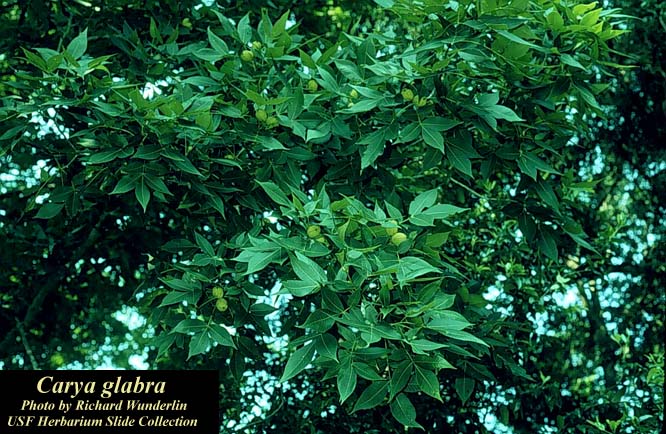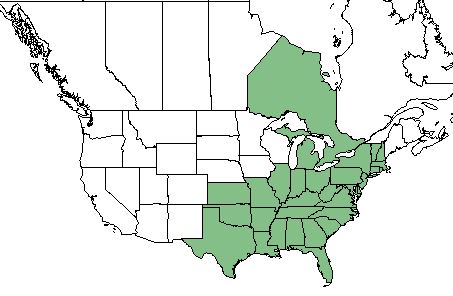Difference between revisions of "Carya glabra"
(→Ecology) |
|||
| Line 40: | Line 40: | ||
This species is thought to be dispersed by consumption by vertebrates. <ref> Kirkman, L. Katherine. Unpublished database of seed dispersal mode of plants found in Coastal Plain longleaf pine-grasslands of the Jones Ecological Research Center, Georgia.</ref> | This species is thought to be dispersed by consumption by vertebrates. <ref> Kirkman, L. Katherine. Unpublished database of seed dispersal mode of plants found in Coastal Plain longleaf pine-grasslands of the Jones Ecological Research Center, Georgia.</ref> | ||
| − | + | ===Seed bank and germination=== | |
| + | For propagation, it is easiest to sow seeds immediately after collecting or to stratify them and sow in the spring. To overcome embryo dormancy, moist stratification should be conducted between 33-40 degrees for 30-150 days; older seeds need less stratification.<ref name= "lady bird"/> | ||
| + | |||
===Fire ecology=== <!--Fire tolerance, fire dependence, adaptive fire responses--> | ===Fire ecology=== <!--Fire tolerance, fire dependence, adaptive fire responses--> | ||
''C. glabra'' is not fire resistant, but has a medium fire tolerance. <ref name= "USDA Plant Database"/> | ''C. glabra'' is not fire resistant, but has a medium fire tolerance. <ref name= "USDA Plant Database"/> | ||
Revision as of 15:49, 1 April 2019
Common name: Pignut Hickory [1]
| Carya glabra | |
|---|---|

| |
| Photo by the Atlas of Florida Plants Database | |
| Scientific classification | |
| Kingdom: | Plantae |
| Division: | Magnoliophyta - Flowering plants |
| Class: | Magnoliopsida - Dicots |
| Order: | Juglandales |
| Family: | Juglandaceae |
| Genus: | Carya |
| Species: | C. glabra |
| Binomial name | |
| Carya glabra Mill. | |

| |
| Natural range of Carya glabra from USDA NRCS Plants Database. | |
Contents
Taxonomic Notes
Synonyms: Carya glabra (P. Miller) Sweet var. glabra; Carya glabra (P. Miller) Sweet var. megacarpa (Sargent) Sargent; Carya ovalis (Wangenheim) Sargent var. hirsuta (W.W. Ashe) Sargent; Hicoria glabra (P. Miller) Britton var. glabra; Hicoria glabra (P. Miller) Britton var. hirsuta W.W. Ashe; Hicoria austrina Small
Varieties: none
Description
C. glabra is a perennial tree of the Juglandaceae family native to North America and Canada.[1] Reaching heights of 50-100 feet, it is a large tree with short picturesque branches, and a spreading crown. Bark is coarsely textured. Leaves pinnately compound, which turn golden-yellow in color in the fall.[2]
Distribution
C. glabra is found in the southeastern corner of the United States, as well as the Ontario region of Canada. [1]
Ecology
Habitat
C. glabra is found in a wide variety of forests and woodlands, but most often non-wetland areas. [3] It has also been found along moist roadsides. [4]
Phenology
C. glabra has been observed flowering all months of the year with the exception of January. [5]
Seed dispersal
This species is thought to be dispersed by consumption by vertebrates. [6]
Seed bank and germination
For propagation, it is easiest to sow seeds immediately after collecting or to stratify them and sow in the spring. To overcome embryo dormancy, moist stratification should be conducted between 33-40 degrees for 30-150 days; older seeds need less stratification.[2]
Fire ecology
C. glabra is not fire resistant, but has a medium fire tolerance. [1]
Use by animals
C. glabra is not highly palatable to grazing or browsing animals, but is highly palatable to humans.[1] It is a food source for songbirds and small mammals, and serves as a larval host for the Luna moth (Actias luna), the funeral dagger (Acronicta funeralis), and the giant regal (Citheronia regalis). For humans, the wood is used for broom handles, tool handles, sport implements, and skis.[2]
Conservation and Management
Cultivation and restoration
Photo Gallery
References and notes
- ↑ 1.0 1.1 1.2 1.3 1.4 USDA Plant Database https://plants.usda.gov/core/profile?symbol=CAGL8 Cite error: Invalid
<ref>tag; name "USDA Plant Database" defined multiple times with different content - ↑ 2.0 2.1 2.2 [[1]] Lady Bird Johnson Wildflower Center. Accessed: April 1, 2019
- ↑ Weakley, A. S. (2015). Flora of the Southern and Mid-Atlantic States. Chapel Hill, NC, University of North Carolina Herbarium.
- ↑ URL: http://herbarium.bio.fsu.edu. Last accessed: June 2018. Collectors: L. B. Trott, Donald E. Stone, H. Kurz, L. Baltzell, A. F. Clewell, S. W. Leonard, - Thompson, Robert K. Godfrey, Patricia Elliot, Loran C. Anderson, K. Craddock Burks, D. B. Ward, D. Burch. States and counties: Wakulla County Florida, Escambia County Florida, Liberty County Florida, Marion County Florida, Madison County Florida, Franklin County Florida, Walton County Florida, Santa Rosa County Florida, Leon County Florida, Gadsden County Florida, Hernando County Florida, Taylor County Florida, Okaloosa County Florida, Jefferson County Florida, Suwannee County Florida, Hamilton County Florida, Hardee County Florida, Levy County Florida, Sarasota County Florida, Columbia County Florida
- ↑ Nelson, G. PanFlora: Plant data for the eastern United States with emphasis on the Southeastern Coastal Plains, Florida, and the Florida Panhandle. www.gilnelson.com/PanFlora/ Accessed: 17 MAY 2018
- ↑ Kirkman, L. Katherine. Unpublished database of seed dispersal mode of plants found in Coastal Plain longleaf pine-grasslands of the Jones Ecological Research Center, Georgia.